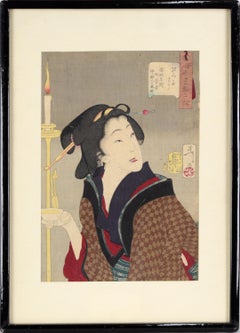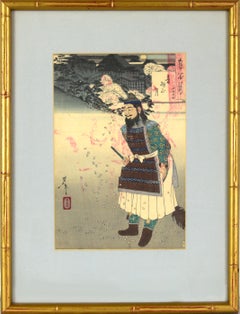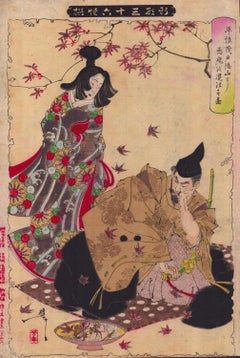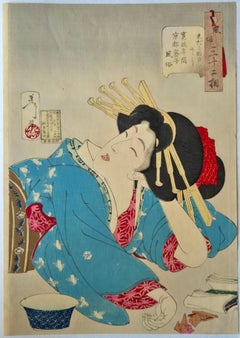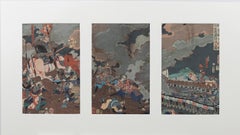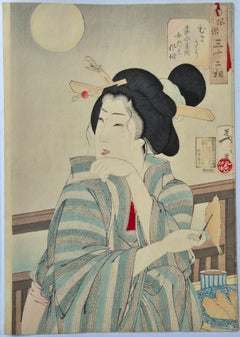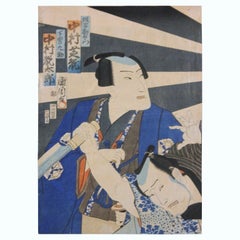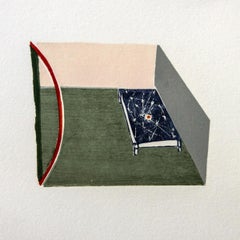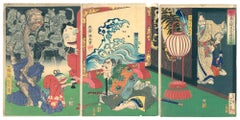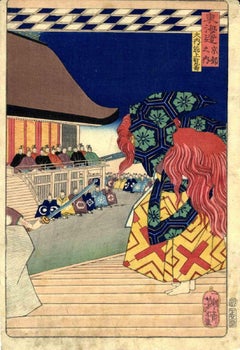Tsukioka Yoshitoshi Art
Japanese, 1839-1892
Born in Edo in 1839, Yoshitoshi became a student of noted woodblock artist Kuniyoshi in 1850, at the age of eleven. His first print, a triptych of a historical naval battle, was issued just three years later. After Kuniyoshi's death in 1861, Yoshitoshi earned his living designing prints of kabuki actors.
The 1860s were a time of increasing political unrest in Japan. A witness to the Battle of Ueno, a massacre of the shogun's supporters by imperial forces in 1868, Yoshitoshi's bloody battle prints during this period reflect the violence and upheaval of the time.
Yoshitoshi experienced some commercial success in the late 1860s, earning popularity designing prints for newspapers, but in 1871 he fell into a deep depression, living in poverty and unable to work. The year 1873 marked a rebirth for Yoshitoshi, as he emerged from his illness and began using a new go or artist name: Taiso, which means great resurrection. The following decades would see the production of his greatest work.
Considered his masterwork, Yoshitoshi's series One Hundred Aspects of the Moon was published from 1885-1892. These quiet and reflective prints, beautifully composed and drawn, feature subjects from traditional Japanese and Chinese history and legend, rendered with great sensitivity and emotion. Yoshitoshi's other important series from this period include New Forms of Thirty-six Ghosts and Thirty-two Aspects of Customs and Manners.
Sadly, Yoshitoshi's mental illness returned, and he was hospitalized in 1891. He continued to work intermittently, but died of a cerebral hemorrhage in 1892 at the age of fifty-three.
Yoshitoshi was the most influential woodblock print artist of Meiji era Japan. His prints shimmer with energy and bring to life the tales of ancient Japan: the downfall of the once mighty, untouchable beauty, military conquests, and slices of everyday life. A consummate draftsman and imaginative designer, Yoshitoshi brought creativity, emotion, and elegance to images that continue to resonate with audiences today.to
3
3
2
2
Overall Width
to
Overall Height
to
6
1
1
6
1
7
6
5
2
2
1
1
1
1
1
1
1
7
2
2
9
10,138
2,779
1,375
1,369
3
4
2
1
Artist: Tsukioka Yoshitoshi
"Thirsty: the appearance of a town geisha in the Ansei era" - Woodblock on Paper
By Tsukioka Yoshitoshi
Located in Soquel, CA
"Thirsty: the appearance of a town geisha in the Ansei era" - Woodblock on Paper
From the series "Thirty-two Aspects of Customs and Manners" (Fuzoku sanjuniso)
Lively woodblock of a...
Category
1880s Edo Tsukioka Yoshitoshi Art
Materials
Paper, Ink, Woodcut
One Hundred Aspects of the Moon, Mt Otawa Moon - Bright God Tamura
By Tsukioka Yoshitoshi
Located in Soquel, CA
"Mount Otawa Moon: Bright God Tamura" - Woodblock on Paper by Tsukioka Yoshitoshi
From the series "One Hundred Aspects of the Moon"
This piece depicts the general Sakanoe no Tamura...
Category
1880s Edo Tsukioka Yoshitoshi Art
Materials
Paper, Ink, Woodcut
Yoshitoshi: Taira no Koremochi Vanquishing the Demon of Mount Togakushi
By Tsukioka Yoshitoshi
Located in BRUCE, ACT
Tsukioka Yoshitoshi
Taira no Koremochi Vanquishing the Demon of Mount Togakushi
From Series: “New Forms of Thirty-six Ghosts”
「新形三十六怪撰」 「平惟茂戸隠山に悪鬼を退治す図」
C. 1890
Size: Oban
Ex...
Category
1890s Tsukioka Yoshitoshi Art
Materials
Woodcut
$1,302 Sale Price
30% Off
Tsukioka Yoshitoshi -- Looks Slovenly', Mannerisms of a Kyoto Geisha
By Tsukioka Yoshitoshi
Located in BRUCE, ACT
Tsukioka Yoshitoshi
Looks Slovenly', Mannerisms of a Kyoto Geisha from the Kansei Period from Thirty-Two Daily Scenes (風俗三十二相), 1888
Woodblock print
Oban
The image depicts a geisha...
Category
1880s Tsukioka Yoshitoshi Art
Materials
Woodcut
Tsukioka Yoshitoshi (1839-1892) -1866 Japanese Woodblock, Battle Of Kawanakajima
By Tsukioka Yoshitoshi
Located in Corsham, GB
An extraordinary ukiyo-e triptych by one of the greatest ukiyo-e artists of the 19thC, Tsukioka Yoshitoshi (1839-1892). The triptych shows a dramatic scene from the epic, bloody four...
Category
Mid-19th Century Tsukioka Yoshitoshi Art
Materials
Woodcut
Tsukioka Yoshitoshi -- Looking Tasty, the Appearance of a Prostitute during the
By Tsukioka Yoshitoshi
Located in BRUCE, ACT
Tsukioka Yoshitoshi
Looking Tasty, the Appearance of a Prostitute during the Kaei Era from Thirty-Two Daily Scenes (風俗三十二相), 1888
Woodblock print
Oban
This piece depicts a woman on...
Category
1880s Tsukioka Yoshitoshi Art
Materials
Woodcut
Tsukioka Yoshitoshi -- Kasagawa Higezo Subduing an Ox
By Tsukioka Yoshitoshi
Located in BRUCE, ACT
Tsukioka Yoshitoshi
Kasagawa Higezo - 笠川髭蔵. from the series KINSEI KYOGIDEN - “Hero Biographies of the Modern Era“ (近世侠義傳)
Original woodblock print , published 1865, 10th month
Oban
...
Category
1960s Tsukioka Yoshitoshi Art
Materials
Woodcut
Related Items
Two Kabuki Actors Japanese Woodblock Print
By Toyohara Kunichika
Located in Houston, TX
Two kabuki actors posing a samurai's. The print is printed on rice paper and is not framed. It is stamped by the artist with details about the actors in ...
Category
1860s Edo Tsukioka Yoshitoshi Art
Materials
Woodcut
Room with a red arch - XXI Century, Contemporary Linocut Woodcut Print, Colorful
By Maria Stelmaszczyk
Located in Warsaw, PL
Maria Stelmaszczyk is a Polish artist born in 1983.
PROVENANCE
Exhibited at Katarzyna Napiorkowska Gallery.
The Gallery is a primary representative for this artist.
The Gallery o...
Category
Early 2000s Contemporary Tsukioka Yoshitoshi Art
Materials
Paper, Woodcut, Linocut
Constellation - XXI Century, Contemporary Linocut & Woodcut Print, Abstract
By Maria Stelmaszczyk
Located in Warsaw, PL
MARIA STELMASZCZYK (born in 1983) Studies at the Faculty of Graphic Arts and Painting
Laboratory of Woodcut Techniques and Artistic Book at the Academy of Fine Arts Władysław Strzemi...
Category
Early 2000s Contemporary Tsukioka Yoshitoshi Art
Materials
Paper, Linocut, Woodcut
Tolosa (Toulouse); Leaf LXXI from Hartmann Schedel's Nuremberg Chronicle
Located in Middletown, NY
Woodcut on laid paper, 8 3/8 x 9 1/8 inches (212 x 233 mm), the full sheet. In excellent condition with text and portraits of Empedocles, Sapho, Zeuxis and others on the verso, as is...
Category
15th Century and Earlier Old Masters Tsukioka Yoshitoshi Art
Materials
Ink, Handmade Paper, Laid Paper, Woodcut
Painting in Gold Frame
By Roy Lichtenstein
Located in Aventura, FL
From the Paintings series. Woodcut, Lithograph, screen print and collage on Arches 88 paper. Hand signed, dated and numbered by Roy Lichtenst...
Category
1980s Pop Art Tsukioka Yoshitoshi Art
Materials
Lithograph, Screen, Woodcut, Paper
Edo Landscape Japanese Woodblock Print
By Utagawa Hiroshige (Ando Hiroshige)
Located in Houston, TX
Edo Meisho woodblock print of a famous Japanese coastal dock. This woodblock is most likely apart of the series "One Hundred Famous Views of Edo." The woodblock print is printed on r...
Category
1850s Edo Tsukioka Yoshitoshi Art
Materials
Woodcut
$1,500
H 10 in W 15 in D 0.004 in
The Triumph of Caesar: Plate IV of IX
By Andrea Mantegna
Located in Middletown, NY
Andreani, Andrea, after Andrea Mantegna
The Triumph of Caesar: Plate IV of IX
1599. Chiaroscuro woodcut in colors printed from four blocks on laid paper in dark brown, grey, and thr...
Category
16th Century Old Masters Tsukioka Yoshitoshi Art
Materials
Handmade Paper, Laid Paper, Ink, Woodcut
Shunga - Woodcut by Katsukawa Schuncho - Mid-18th Century
By Katsukawa Shunshō
Located in Roma, IT
Shunga is an original modern artwork realized by Katsukawa Schuncho (1726 – 1793) in the half of the 18th Century.
Erotic scene from the series "Koshuko zue juni ko".
A courtesan with a customer under a kimono stand...
Category
Mid-18th Century Modern Tsukioka Yoshitoshi Art
Materials
Paper, Woodcut
$3,359
H 7.88 in W 11.82 in D 0.04 in
Rockwell Kent, Four Bookplates (on one sheet)
By Rockwell Kent
Located in New York, NY
Proof sheet with four wood engraved book plates by Rockwell Kent. Possibly for a book on this subject published in 1937. There are pencil numbers under each image that probably indic...
Category
Early 20th Century Art Deco Tsukioka Yoshitoshi Art
Materials
Woodcut
Courtesan - Woodcut by Keisai Eisen - 1830
By Keisai Eisen
Located in Roma, IT
Courtesan is an original modern artwork realized by Keisai Eisen in the first half of the 19th Century.
Signed and inscribed on plate.
Total dimension...
Category
1830s Modern Tsukioka Yoshitoshi Art
Materials
Paper, Woodcut
"Dawn Inside the Yoshiwara" Utagawa Hiroshige, Japanese Landscape, Ukiyo-e
By Utagawa Hiroshige
Located in New York, NY
Utagawa Hiroshige
Dawn Inside the Yoshiwara, circa 1857
Woodblock print
11 x 7 inches
Utagawa Hiroshige is recognized as a master of the ukiyo-e woodblock printing tradition, havin...
Category
1850s Naturalistic Tsukioka Yoshitoshi Art
Materials
Paper, Ink, Woodcut
Sculptor at Work - Woodcut after Takakane Fujiwara - 1950s
Located in Roma, IT
Sculptor at work is an artwork realized in the Early 20th Century after Takakane Fujiwara.
Sheet dimensions: 30 x 19.5 cm.
Reprint.
Good conditions.
Category
1950s Modern Tsukioka Yoshitoshi Art
Materials
Paper, Woodcut
Previously Available Items
Tsukioka Yoshitoshi - Naoyuki Conquers the Old Badger at Fukashima's Mansion
By Tsukioka Yoshitoshi
Located in BRUCE, ACT
Tsukioka Yoshitoshi 芳年
Naoyuki Conquers the Old Badger at Fukashima's Mansion
於吹島之館直之古狸退治図
Original woodblock prints
Good condition, impress colour
Oban
1866
Category
1860s Tsukioka Yoshitoshi Art
Materials
Woodcut
Performance in the Imperial Palace - Woodcut Print by T. Yoshitoshi - 1860s
By Tsukioka Yoshitoshi
Located in Roma, IT
Performance in the imperial palace is an original artwork realized by Tsukioka Yoshitoshi (also named Taiso Yoshitoshi; 30 April 1839 – 9 June 1892) in 1863.
Woodcut print.
Dimensions: 22 x 15 cm.
From the series "Tokaido, Kyoto no uchi" (The Tokaido road, in Kyoto) the sheet "Ouchi no joran zu" (No performance in the imperial palace). Nightly performance outdoors in the palace before guests and courtiers. On stage actor with demon mask...
Category
1860s Modern Tsukioka Yoshitoshi Art
Materials
Woodcut
H 8.67 in W 5.91 in D 0.04 in
Tsukioka Yoshitoshi art for sale on 1stDibs.
Find a wide variety of authentic Tsukioka Yoshitoshi art available for sale on 1stDibs. You can also browse by medium to find art by Tsukioka Yoshitoshi in woodcut print, ink, paper and more. Not every interior allows for large Tsukioka Yoshitoshi art, so small editions measuring 14 inches across are available. Customers who are interested in this artist might also find the work of Utagawa Yoshitora, Kunichika Toyohara, and Utagawa Hiroshige (Ando Hiroshige). Tsukioka Yoshitoshi art prices can differ depending upon medium, time period and other attributes. On 1stDibs, the price for these items starts at $760 and tops out at $8,600, while the average work can sell for $3,285.
